Canada 1986 "Exploration of Canada I, Discoverers"
| <prev | back to index | next> |
| Issue Date | 29.08.1986 (Sheet of 50 stamps) 01.10.1986 (Souvenir-Sheet) |
| ID | Michel: 1004-1007, Bl.5 ; Scott: 1107a, 1107b ; Stanley Gibbons: 1208a, MS1212 ; Yvert et Tellier: 964-967, BF6 ; Category: pF |
| Design | Designed by Frederick Hagan Typographed by J.F. Britton |
| Stamps in set | 4 |
| Value |
34 cent - A Continent and Its Peoples 34 cent - Vikings sail Westward 34 cent - John Cabot makes his Landfall 34 cent - Hudson Bay discovered |
| Emission/Type | commemorative |
| Places of issue | Ottawa |
| Size (width x height) |
stamps: 12.5mm x 13mm Mini-Sheet: 119mm x 84mm |
| Layout | Sheet of 50 stamps: 10 rows, 5 stamps each (issued on 29.08.1986), Souvenir-Sheet of 4 (issued on 01.10.1986) |
| Products | FDC x2 |
| Paper | HP - Harrison and Sons Inc. paper, no Watermark |
| Perforation | 12,50 x 13 |
| Print Technique | Offset lithography |
| Printed by | Ashton-Potter Limited, Canada |
| Quantity | stamps: 5,285,000, 4,940,000, 5,285,000, 4,940,000; Souvenir-Sheet: 700,000 |
| Issuing Authority | Canadian Post |
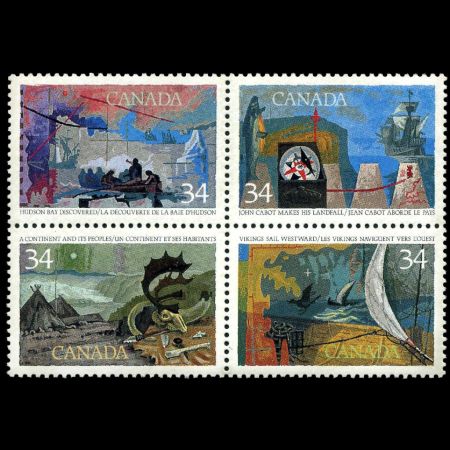
On August 28 1986, Canadian Post issued the first stamps set of multi-year series "Exploration of Canada" - "Exploration of Canada (series 1) Discoverers". (The last set was issued in 1989) These stamps were printed in sheet of 50 with 5 stamps per row. Some stamps were printed 2 times in the row, other 3 times.
Artist Frederick Hagan of Newmarket, Ontario, painted the four images. Through landscape, maps and other cultural objects, these stamps present a variety of moods, characters and experiences rather than a literal approach to the subjects. J.F. Britton of Oakville worked with the artist on developing the typography for the stamp designs.
On October 1st 1986, the same stamps were issued as a Souvenir-Sheet to draw attention to the upcoming international philatelic exhibition, CAPEX 87, to be held in Toronto in 1987.
These four stamps, the first in a series, honour discoverers of Canada who stand in the forefront of those who have risked everything to discover the unknown. Some 12,000 years ago, Canada's first explorers arrived here from Siberia, via Alaska. As the huge glaciers covering much of Canada retreated, these first people and their descendants discovered and occupied the entire continent.
Archaeologists believe that the Indians and the Inuit migrated from Asia across the Bering Strait to explore most of Canada.
The first known Europeans to visit Canada were the Vikings, who landed in northern Newfoundland about 1000 AD, although there is some evidence that they may have been preceded by Buddhist monks from China in 458 AD or by Irish monks in the sixth century.
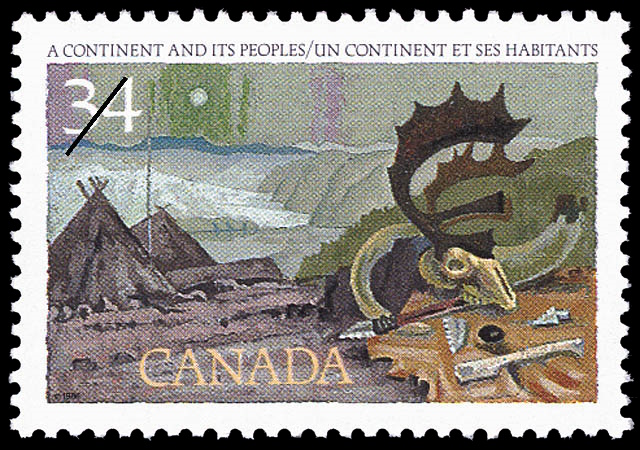 |
| Stone age camp on stamp of Canada 1986, MiNr.: 1004, Scott: 1104. |
Cabot's discovery led to the establishment of a European fishery on the Grand Banks of Newfoundland. His sailing directions were probably used by Jacques Cartier on his 1534 and 1535 voyages.
The British explorer, Henry Hudson, helped discover the north-eastern part of the continent as the search for a North-West Passage to Asia continued.
After John Davis's three voyages (1585-7) delineated much of the Davis Strait region, Hudson traversed Hudson Strait and discovered Hudson Bay in 1610.
One of these stamps shows a stone age campsite with tools and bones, including the skull of a prehistoric deer.
Products and associated philatelic items
| Souvenir-Sheet: CAPEX'87 (issued on October 1st, 1986) | ||
| Souvenir-Sheet | FDC | Example of Circulated Covers |
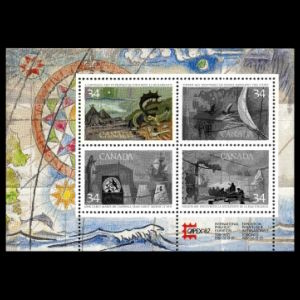 |
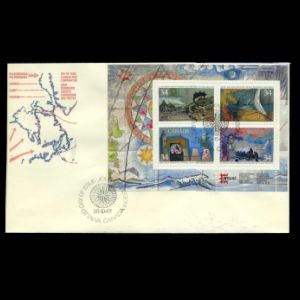 |
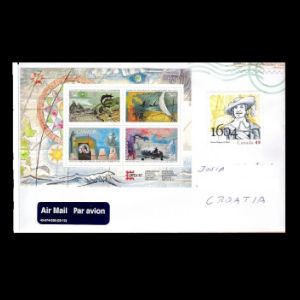 |
| Stamps Sheet | FDC | |
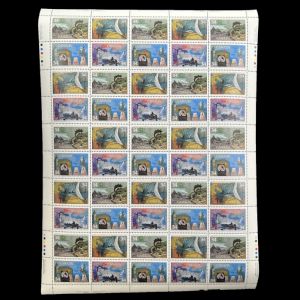 |
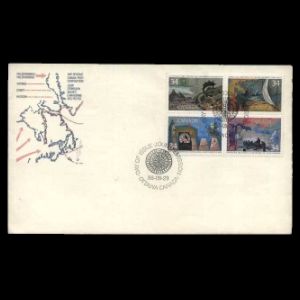 |
|
| The cachet design is based on a part of Luke "North West" Foxe's map of 1635. The native peoples' migration routes and early European Explorers' routes are shown in relation to landmasses as they were known at the time. | ||

|
References
Technical details and description of the stamps:The Postage Stamp Press Release of Canada Post Corporation, reverse side of an FDC, colnect.
Acknowledgements
Many thanks to Dr. Peter Voice, PhD Department of Geological and Environmental Sciences, Western Michigan University, USA, for his help in finding information and for review of a draft of this article.| <prev | back to index | next> |